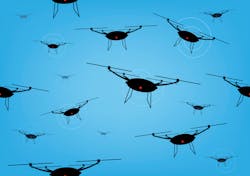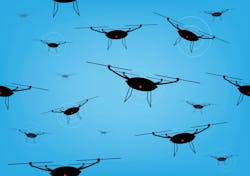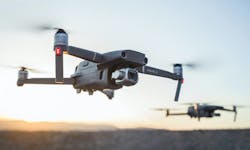Weaponization of Commercial Drones is a Global Threat
Nation-state military operations in Ukraine, Syria, and Nagorno Karabakh underline how drones are integral to modern military operations. One of the lessons Russians took from the 2020 Nagorno-Karabakh war was how mass use of loitering munitions is key to military success. Lessons from these conflicts are now becoming incorporated by nonstate actors in low-intensity operations. Military operations from the first Gulf war to the conflict in Ukraine today, have migrated technologies and methods into the hands of insurgents, terrorists, criminal actors, industrial spies, conventional forces and more. Drone technologies are informing a variety of state and non-state actors on how to adopt battlefield lessons for the entire spectrum of unconventional, conventional warfare, espionage, and criminal purposes.
Military battlefield lessons are often incorporated into actions by non-state actors that can very well visit our own shores. A recent FAAS Information Note, titled ‘Russia-Ukraine Conflict: UAS Operations May Inspire Adversaries’ dated 11 July 2022 underlines exactly this possibility.
“Combat operations associated with the further Russian invasion of Ukraine have featured extensive use of unmanned aircraft systems (UAS), generating heightened publicity and accessible lessons learned that could inform and inspire state and non-state actors, terrorist/militants’ elements, or criminal elements to further incorporate or improve upon their respective operators. If such developments take place, the UAS lessons learned could lead to increased direct or indirect risks to civilian aviation, particularly if/as a variety of actors increasingly employ UAS in other conflict zones or outside the combat zones for hostile, malicious, or illicit uses.”This FAA notification came a week before testimony of DHS and FAA officials to the Senate Homeland Security Committee. Acting Assistant Secretary for Counterterrorism and Threat Prevention Samantha Vinograd, at the Department of Homeland Security, revealed:
- U.S. Customs and Border Protection have detected more than 8,000 illegal cross-border drone flights at the southern border just since August 2021.
- Cartels and transnational criminal organizations use drones to smuggle drugs and surveil US law enforcement in furtherance of illicit cross-border activity. These cartels have also weaponized drones.
- There have been 2000 sightings of drones in and around airports since 2021, with 64 aircraft, four of them commercial flights, having to take evasive actions
Global threats have domestic implications for Homeland Security as the weaponization of commercial drones is now common in conflicts around the world.
The Drone Threat is Widespread
The scope of threats is not limited to kinetic attacks. Other concerns include the use of drones for Industrial espionage, criminal activities ranging from assassinations to border surveillance and smuggling, prison contraband delivery, domestic spying, and even delivering chemical and biological agents.
The Russians have often commented that they learned from the Operations of U.S. military during the Gulf War. During the war in Iraq, the Russian military witnessed how new technologies and tactics were being perfected. They referred to it as the Revolution in Military Affairs or “RMA.” They were especially impressed with America’s military ‘Net-Centric warfare networks,” precision-guided munitions, and what they referred to as the broad “information warfare” strategy. Information warfare was the full spectrum of techniques to deny the enemy intelligence, data, communications, and information critical to the warfighting plans of the adversary.
One of the techniques our military deployed in the first Gulf war was the use of “Graphite bombs’ to short circuit electrical grids and cyber-attacks on the Phillips telephone switches. The graphite bomb was first used against Iraq in 1990–1991, knocking out 85% of the electrical supply. Once the bomb was ejected from a plane or missile, the device's explosive is activated at a set altitude over the target, detonating into a large gas-like plume over the targeted electrical transformer systems.
Fast forward to July of 2020, Hershey, PA, where the first known case of a “modified unmanned aircraft system likely being used in the United States to specifically target energy infrastructure,” states the Joint Intelligence Bulletin (JIB) from DHS and FBI.
The device is similar in concept to” blackout bombs” used by the US Air Force, but without explosives to scatter conductive filaments over electrical equipment. These were also used against Serbia’s electricity generation capacity in 1999 during the Kosovo war.
While the Hershey, PA incident is not an exact replica of the Iraq or Serbia cases, the purpose and method similarities are striking. The drone contains long tethers of copper wire in an attempt to provoke a short circuit upon contact with a transformer. US law enforcement has recently identified and convicted domestic extremists intent on electrical grid attacks. This is one example of how old and new technologies introduced in foreign military conflicts can inform and impact our domestic security.
The New Drone Battlefield is a Reality
Ukraine has been the laboratory for Russian military hybrid, conventional and information warfare (IW) especially electronic warfare (EW). It is the testing ground not only for technologies but for military tactics for combat operations. Advanced Remotely Piloted (RPV) vehicles and drones can employ a variety of electronic countermeasures, in addition to implementing their own jamming, intercept, and other forms of SIGINT attacks. The electronic battlefield is a reality in Ukraine today. The ability to use the RF spectrum for both passive and active military operations ranging from drone/aircraft and missile detection is a daily reality. The ability to target enemy positions and equipment while protecting your forces, population and critical infrastructure from the enemy’s counter-efforts is vital.
One of the primary lessons learned from the annexation of Crimea and occupation of the areas in Donbas in 2016 was how Russia used EW. During this campaign, the jamming of communications to deny services, and the spoofing of GPS systems forced Ukrainian forces to use maps. Russia also used cyber-attacks against communications, Ukrainian UAVs and to attack key installations. U.S. military understands well that being static in one piece of the electromagnetic (EM) spectrum guarantees failure. You will be targeted and jammed.
The Ukrainian military has shown itself to be highly resourceful and adaptive. Despite power outages and destroyed telephone infrastructure, the Ukrainian military harnessed the power of the SpaceX Starlink satellite communications system to operate and succeed in difficult communication, command and control, battlespaces. Ukrainian drone unit Aerorozvidka (Aerial Reconnaissance) used the Starlink low earth satellite system to keep the Ukrainian military-connected allowing its drones to target Russian troops, tanks, headquarters, supply vehicles and drop explosives. Starlink enabled Ukrainian teams to communicate and share intelligence with each other even in very rural parts of the country. When Russian EW forces jammed Starlink, the software-defined communications system was re-coded on the fly to quickly re-establish communications.
Ukrainian, Russian and proxy forces are utilizing a variety of technologies and tactics that integrate UAS crafts for warfighting advantage. These military operations go well beyond kinetic force alone. The Ukrainian and Russian militaries are integrating drones into all aspects of military plans. This includes ISR, surveillance and target acquisition, intelligence collection, kinetic operations, electronic warfare, and psychological operations (PSYOPS) as well as cyber operations. Ukraine has outfitted quadcopters to drop 82mm mortar shells.
Drones have transformed the way the military wages war, making it possible to gather unprecedented amounts of aerial imagery using nearly undetectable platforms to strike targets without putting pilots at risk. Russia has utilized significant numbers of Chinese DJI commercial drones for a variety of military purposes.
Ukraine’s Vice Prime and Minister of Digital Transformation called on DJI to block drones that are used by the Russian military in Ukraine. Russian forces have also learned to change DJI firmware to negate traditional DJI drone detection technologies to avoid mitigation actions. Russia has freely used a drone-tracking system called DJI AeroScope to target the exact location of Ukrainian drone pilots and, allegedly, kill them with mortar strikes and missiles.
Presently, the full impact of drones in Ukraine is distorted by Russia’s lack of their own UAS supply forcing them and to seek Chinese and Iranian products.
Loitering Munitions or Kamikaze Drone
These are aerial weapon systems that wait passively about a target area and attack once a target is located. Loitering munitions enable faster reaction times accelerating the kill chain, especially against concealed or hidden targets such as EW units that emerge for short periods close to the target area.
Today, we can see the far-reaching and evolving employment of military as well as commercially available drones in warfare and kinetic operations. From cartels' use in assassinations, as well as their decisive role in the Nagorno-Karabakh conflict between Azerbaijan and Armenia. Heavily aided by precision-guided smart munitions drones from Turkey and “kamikaze” drones from Israel, Azerbaijan was able to shrink the battlefield and eliminate the effectiveness of the opposing Armenian tank forces sent to repel the Azeri military. This was significantly aided by precision-guided smart munitions drones from Turkey and “kamikaze” drones from Israel.
Challenges
Domestically we have no unified database to accurately assess the threat level from drones. Without a comprehensive set of data on UAV flights and behavior, it will be impossible to formulate risk. There is a lack of command-and-control capabilities that can fuse sensor data, analytic assessments, and mitigation responses to respond quickly to threats. The need to develop a ConOps plan for multiple jurisdictions working with law enforcement agencies at all levels is vital. In short, there is no clear picture of drone activities across metropolitan areas and critical infrastructure centers.
Our current laws and regulations aren’t designed for this new kind of threat. Current electronic eavesdropping laws prevent government officials from disabling drones midair with electromagnetic signals.
Today counter-UAS mitigation technologies are an exclusive province of the federal government. Credit the Biden administration in proposing Congress legislate new drone mitigation authorities for state and local law enforcement organizations. The “Domestic Counter-Unmanned Aircraft Systems National Action Plan” calls for a trial program of select state, local, and tribal agencies to develop detection and mitigation options. This would allow “critical infrastructure owners and operators” to “purchase authorized equipment to be used by appropriate law enforcement agencies to protect their facilities” from an approved drone detection vendor list.
It would authorize the entablement of a database for all government agencies to track drone-related incidents. A National Counter-UAS Training Center would increase training accessibility and interagency cross-training. Additionally, the plan would enhance cooperation with the international community on counter‑UAS technologies, as well as the systems designed to defeat them. All vitally important.
Acting DHS Assistant Secretary for CT/TP Samantha Vinograd testified that "DHS cannot be everywhere. We rely...on state, local, tribal, and territorial partners to help us protect and to advance a variety of DHS missions. If (state-local-territorial) partners are granted this authority, they can help prevent catastrophic attacks against -- against mass gatherings of a variety of size and in a variety of venues."
Today, off-the-shelf commercial drone technology poses a significant threat to governments, corporations, critical infrastructure, and the public. Our first step must be to establish a baseline of drone activities at the border and in key metropolitan and critical infrastructure locations to create a database of drone activities for an informed threat assessment. The Biden plan requires Congressional action.
On July 29, a bipartisan bill was introduced in the U.S. Senate to renew and expand DHS and DOJ tools to effectively control UAS activities. The Bill creates a pilot program with state and local law enforcement to mitigate UAS threats and requires DHS to create a database of UAS occurrences.
This must be matched with legal reforms that allow greater mitigation options distributed among various qualified law enforcement organizations. The size of the challenge in a nation that is continental in size and has such an enormous air transportation commercial industry supported by widely dispersed critical infrastructure facilities requires an action plan to determine and address the current threat environment.
FBI Director Christopher Wray said it best when he testified before the Senate in 2021 "A year ago, it was an emerging problem. Now it's a real problem. So, we are quickly trying to up our game."
About the author: Paul M. Joyal is Managing Director for Public Safety, Homeland Security and Intelligence at NSI, LLC in Washington, D.C., and is also a security analyst and media commentator who frequently comments on political and security matters concerning Russia and former Soviet countries. A critic of the administration of Russian president Vladimir Putin, in late February 2007 Joyal told Dateline NBC that the murder of former KGB agent Alexander Litvinenko served as a warning to all critics of the Putin government. A few days later, on March 1, Joyal was shot and wounded outside his home in Adelphi, Maryland. The Washington Post reports that the attack is under investigation by the FBI. Earlier that evening, Joyal had dined with former KGB general Oleg Kalugin; Kalugin (whom the Russian Government accused of being a US agent) later told the Washington Post that he was not sure whether the attack was politically motivated.
The Growing Threat
On a global basis, there are increasing examples of how drones provide a growing threat domestically. A few key examples are:
- Drone surveillance of nuclear power plants:
§ Fall 2014: In France, unidentified UAVs flew in restricted airspace by 13 of 19 nuclear power plants in a coordinated and organized manner.
§ On January 14th, 2022, Swedish police reported unidentified large drones flying over at multiple nuclear power plants.
- Government High-Security locations
§ In April of 2018, a drone bearing a radiation sticker & carrying trace radioactive material was found on the rooftop of the Japanese Prime Minister’s residence.
- Airports
§ In 2018, Gatwick Airport in London was shut down for two `full days costing over $65M in lost revenues.
§ In July 2022, Washington’s Reagan National Airport was closed after a drone was identified near the runway.
§ On January 5-6, 2018, a swarm of drones attacked Russia's Syrian outpost at Khmeimim Air Base On January 15, 2022, Iran-backed Houthi militants in Yemen used advanced missiles and drones on Abu Dhabi’s airport.
Drones with various kinds of improvised munitions have steadily proliferated among terrorists and other arms groups in Iraq and Syria. ISIS used drones to drop crude bombs on U.S. and allied forces.
- Cartels and Criminals
§ On July 25, 2020, a civilian self-defense militia in the city of Tepalcatepec, Mexico, recovered two dozen explosive-laden quadcopters from a car that a team of cartel hitmen – had abandoned.
- Prisons
§ Drones have been used to deliver contraband, cell phones and even weapons to inmates in prisons throughout the United States.
- Borders
§ Mexican smugglers have flown drones over 8000 times above the border to spy on the movement of patrolling federal officers.
- Intellectual Property and Insider Trading
§ Drones have been detected landing on government and commercial buildings for extended periods. Even hobby drones can carry small Raspberry Pi computers, used to sniff out Wi-Fi signals. They could target critical infrastructure that cannot be accessed from the internet. They could even use electronic warfare to jam communications, or Electro Magnetic Pulse (EMP) to fry servers and telecommunications devices.
- Stadiums
§ Police could identify the location of a drone operator outside of the Dallas Cowboy AT&T Stadium 20 minutes before the kickoff of the NFL playoff game thanks to the Hidden Level, a passive RF collection system deployed over the Arlington entertainment district. The Hidden Level system allowed Arlington PD to respond to the precise location of the UAS launch, interview the operator, recall the drone from the stadium and ticket the operator for failure to abide by FAA regulations by local ordinance.
- Olympics
§ The upcoming Los Angeles Olympics, with its multiple dispersed venues within hundreds of square miles, presents a perplexing challenge.
LAPD testified during a case of UAS collision with an LAPD helicopter that if the drone had hit a rotor it could have caused the aircraft to crash resulting in serious human and property losses.
About the Author

Paul M. Joyal
security analyst and media commentator
Paul M. Joyal is a security analyst and media commentator who frequently comments on political and security matters concerning Russia and former Soviet countries. A critic of the administration of Russian president Vladimir Putin, in late February 2007 Joyal told Dateline NBC that the murder of former KGB agent Alexander Litvinenko served as a warning to all critics of the Putin government. A few days later, on March 1, Joyal was shot and wounded outside his home in Adelphi, Maryland. The Washington Post reports that the attack is under investigation by the FBI. Earlier that evening, Joyal had dined with former KGB general Oleg Kalugin; Kalugin (whom the Russian Government accused of being a US agent) later told the Washington Post that he was not sure whether the attack was politically motivated.
Joyal holds a master's degree in international relations from the Catholic University of America. He was a staff member for the United States Senate Select Committee on Intelligence in 1991, Joyal founded a security consulting company, Intercon International USA Inc., which published a weekly newsletter about security affairs in the former Soviet bloc. He later became a vice president at, and currently serves as managing director at National Strategies Inc. He has been cited as an expert source by many news outlets, including Time Magazine and PBS The NewsHour with Jim Lehrer. His published works include the book Fifteen Years of Espionage (ISBN 0935067140) and "Singling out Arab-Americans," the January 21, 1991, editorial in the Washington Post He has close ties with the government of the Republic of Georgia: in 1998 he acted as the country's first lobbyist to the U.S. Government, and he is listed as the contact for the 501(c)(3) charitable organization founded by former Georgian president Eduard Shevardnadze. In 2005 he spoke at the Georgian Embassy in Washington, DC, at the memorial service for Zurab Zhvania, the former speaker of the Georgian Parliament. In November 2012, over five years after the shooting, his attackers had not been found.



